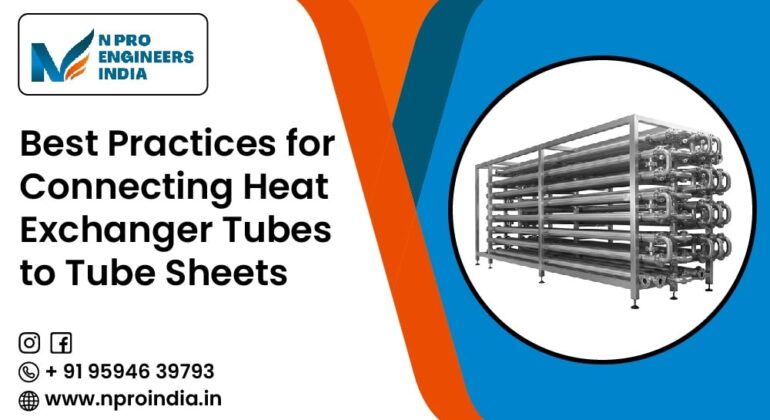Heat exchangers are important components in numerous industrial packages, transferring heat efficiently between two or greater fluids. One of the maximum essential components of a heat exchanger’s layout is the connection among the tubes and the tube sheet. This connection not simplest determines the performance and sturdiness of the warmth exchanger however also affects its safety and upkeep necessities. In this guide, we’ll explore the nice practices for connecting warmth exchanger tubes to tube sheets, the significance of these connections, and how reputable producers like NPRO India make certain first rate solutions.
What is a Tube Sheet?
A tube sheet is a thick, flat plate, commonly a product of metallic, that helps and aligns the tubes within a heat exchanger. It is drilled with precision to create holes wherein the tubes are inserted, secured, and sealed. The connection between the tubes and the tube sheet is essential to prevent leaks, make certain structural integrity, and hold green warmth switches.
Importance of Proper Connections
Improper connections between warmth exchanger tubes and tube sheets can result in:
Leaks: Resulting in loss of fluid and reduced efficiency.
Corrosion: Exposure to fluids can accelerate wear and tear.
Mechanical Failure: Poorly connected tubes can also detach, causing operational issues.
Reduced Efficiency: Inefficient sealing compromises warmth switch.
Following great practices guarantees lengthy-term reliability and most desirable overall performance.
Best Practices for Connecting Tubes to Tube Sheets
- Material Compatibility
Choosing the right materials for each of the tubes and the tube sheet is critical. Compatibility guarantees:
- Resistance to corrosion and thermal pressure.
- Minimal threat of galvanic corrosion among assorted metals.
- Enhanced sturdiness underneath high-stress and excessive-temperature situations.
For example, chrome steel and high-grade alloys are typically used to match the application’s requirements.We are a main tube sheet producer, which gives custom designed materials that meet enterprise requirements and precise purchaser needs.
- Precision Drilling and Tube Insertion
Accurate drilling of holes inside the tube sheet ensures an ideal match for the tubes. Precision prevents:
- Misalignment which can lead to pressure on the tubes.
- Gaps that could motivate leakage.
- Tubes should be inserted cautiously to avoid bending or adverse the material. Automated equipment or superior techniques like CNC machining are typically used to attain accuracy.
- Tube-to-Tube Sheet Expansion
Tube enlargement is a vital step in securing the tube in the tube sheet. There are foremost methods:
Mechanical Expansion: Using equipment to amplify the tube in opposition to the sheet to create a decent seal.
Hydraulic Expansion: Using pressurized fluid to expand the tube uniformly.
Both methods provide sturdy, leak-evidence connections, with hydraulic growth being preferred for its precision and uniformity.
- Welding for Enhanced Security
Welding is often used to reinforce the tube-to-tube sheet connection. Various welding techniques include:
TIG Welding (Tungsten Inert Gas): Ideal for precision and clean welds.
Laser Welding: Provides excessive-electricity connections with minimal distortion.
Explosive Welding: Used for specialized applications requiring excessive durability.
The preference of welding technique relies upon the warmth exchanger’s design and running conditions.
- Testing for Leak-Proof Connections
After connecting the tubes to the tube sheet, rigorous checking out ensures reliability. Common exams consist of:
Hydrostatic Testing: Pressurizing the assembly with water to locate leaks.
Pneumatic Testing: Using air or fuel to test for any leaks beneath pressure.
Dye Penetrant Testing: Identifying floor cracks in welds or joints.
Testing guarantees that the connections meet overall performance and protection requirements. We prioritize stringent nice checks to supply dependable tube sheet solutions.
- Anti-Corrosion Measures
Corrosion is a big undertaking in heat exchanger packages, particularly in environments with harsh chemical substances or saline water. Best practices to mitigate corrosion include:
- Using corrosion-resistant materials like titanium or Inconel.
- Applying protecting coatings to the tube sheet.
- Ensuring right sealing to limit exposure to corrosive factors.
- Regular Maintenance and Inspection
Periodic maintenance and inspection are important to extend the life of the heat exchanger. Key preservation practices consist of:
- Inspecting welds and seals for symptoms of damage or leaks.
- Cleaning tubes to save you fouling and maintain heat transfer performance.
- Replacing damaged tubes or repairing worn connections promptly.
The Role of Tube Sheet Manufacturers
A reliable tube sheet producer performs an important role in making sure the first-rate of the warmth exchanger. Manufacturers like us provide:
Customization: Tailoring tube sheets to precise designs and operational necessities.
Quality Materials: Providing substances that withstand intense conditions.
Precision Engineering: Ensuring correct drilling and machining for ideal fits.
NPRO India is committed to delivering high-overall performance tube sheets that meet industry standards, ensuring seamless tube-to-sheet connections for numerous applications.
Applications of Tube Sheets in Heat Exchangers
Properly related tube sheets and tubes are vital in industries including:
Power Generation: For steam condensers and nuclear reactors.
Chemical Processing: Handling corrosive fluids in reactors and heat exchangers.
Oil and Gas: In offshore platforms and refineries.
HVAC Systems: For efficient cooling and heating systems.
The connection among warmth exchanger tubes and the tube sheet is an important factor in figuring out the performance, protection, and longevity of the equipment. By following satisfactory practices including cloth choice, particular machining, steady connections, and rigorous testing, industries can make sure surest overall performance and reliability.
As a relied on tube sheet manufacturer, NPRO India grants super, customizable answers tailor-made to satisfy the precise needs of numerous industries. Whether you want durable tube sheets for the electricity era or corrosion-resistant alternatives for chemical processing, NPRO India guarantees excellence in each product.
For dependable and efficient tube sheets, agree with NPRO India to meet all of your warmness exchanger requirements.




